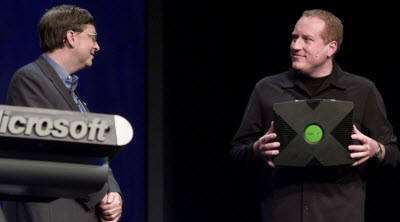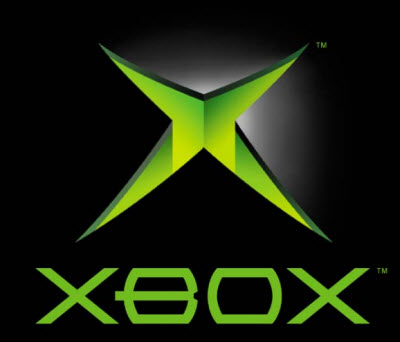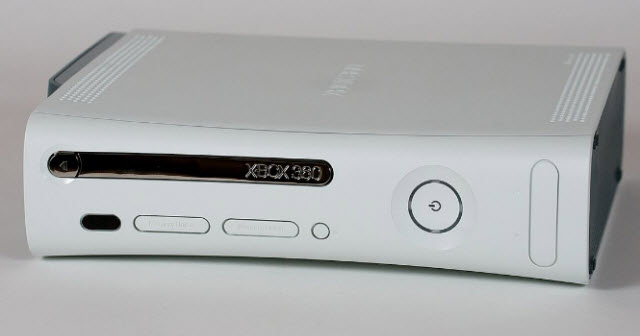Update: Don’t like page breaks? This two-part series is now available as an e-book for the Amazon Kindle.
Editor’s note: This story is the second of two pieces on the 10th anniversary of the launch of Microsoft’s Xbox video game console, which debuted Nov. 15, 2001. The narrative is based on recent interviews as well as my two books: Opening the Xbox: Inside Microsoft’s Plan to Unleash an Entertainment Revolution, published in 2002; and The Xbox 360 Uncloaked: The real story behind Microsoft’s next generation video game console, published in 2006. Part 1 took us through the launch of the Xbox. This story takes us through the aftermath, the launch of the Xbox 360, and the present day state of the video game wars.
It was a miracle that Microsoft got the first Xbox out the door. The company’s first video game console came together in just 20 months from conception to launch. It earned Microsoft a precious toehold in the living room, selling 1.5 million units in its first season. It sold three games for every box and generated $750 million in revenue. Over four years, that grew to 21 million consoles sold.
But Sony won the war for that console generation. The PlayStation 2 sold more than 90 million units by mid-2005, while Nintendo’s GameCube came in a close third with 20 million units sold. With such a lopsided tally, Sony was able to snare exclusive games such as Grand Theft Auto: Vice City and Grand Theft Auto: San Andreas.
To turn things around, Microsoft had to initiate a new console war with its own surprise attack. Instead of being 20 months behind Sony, Microsoft now planned to hit the market at the same time or before Sony came out with its next console. As soon as the Xbox shipped, Microsoft had to start running full blast. The next project was code-named Xenon. Later dubbed the Xbox 360, it would finish what the Xbox had started.
On the night that the Xbox launched in Times Square, chief Xbox officer Robbie Bach was standing with co-creator Seamus Blackley. “Welcome to the starting line,” Bach said. “Fuck off,” Blackley said, laughing because he was so exhausted.
Bill Gates himself summed up his feelings with a Time magazine writer. He said, “The first generation, it’s just like a video game. If you play perfectly, at the end, it says, ‘You get to play again.’ That’s all it says! You put your hand in the till. There’s no quarter down there. There’s no, like, even tickets to buy funny dolls or anything. It’s just, ‘Hey, play again.'”
 Easy come, easy go: $4 billion in losses
Easy come, easy go: $4 billion in losses
Blackley had no more stomach for this second battle. He left Microsoft in the spring of 2002, following his buddy Kevin Bachus out the door. In a recent interview, he had no regrets about leaving.
“The thing I’m really good at is being immune enough to pain to continue to push ideas I really believe in,” he said. “I’m stupid enough to push them even when it is disadvantageous to me. I’m not the right guy to hang out and optimize a business like that.”
A bunch of veterans did stick around. Bill Gates was up for another round, though this time he would do it as chairman, in a secondary role to the newly-minted CEO Steve Ballmer. There were now around 2,000 people in the game division, still less than what Sony had but far more than the 400 that Microsoft had before the Xbox.
But Microsoft had dug itself a hole. After four years, Microsoft’s Home and Entertainment Group reported a total loss of $4 billion. That number included some other money-losing ventures too. But the vast majority of it was due to Xbox and the loss that the company was taking on every machine that it made. Insiders believed that Microsoft lost $3.7 billion on the original Xbox by 2005. That amounted to a $168 loss on every machine that Microsoft sold.
The toughest part was that the machine wasn’t designed to take advantage of declining prices or volume discounts on component manufacturing, the way a mass-market electronics product would ordinarily be designed. That was driven by necessity, since the machine went from idea to product in about half the time it usually took to design such a complicated device. There wasn’t enough time to design unique chips and hardware that could be made more cheaply over time. Microsoft had to take a lot of costly off-the-shelf parts, including an expensive hard disk drive. When the machine started selling for $299, the cost for making each machine was around $425.
Selling games was the way to offset the losses. But game making was getting costly. One Electronic Arts executive estimated that it took 20 employees to make a PlayStation game, 80 to make a PS 2 game, and 150 to make a PS 3 game. Working for two years, the PS 3 game could consume $30 million in payroll costs, not counting marketing. Xbox game making costs were not so different.
At the same time, the price gamers paid for games was dropping. Fewer games were accounting for all of the big unit sales. If a game wasn’t a hit, it could be a huge drain on a game publisher. Microsoft had entered the market to ease the burden on game developers, but their problems were multiplying. After its first round of hits and duds became clear, Microsoft cut back on its own teams that made duds.
Some observers in the industry were astounded at the losses Microsoft was willing to absorb. The company seemed like it was taking profits from its Windows and Office franchises and flushing it down the toilet of the Xbox. Later on, Microsoft’s pile of cash dwindled and the company found other needs for that cash, such as trying to catch up with Google in search. Even so, at the time, losing $4 billion over four years wasn’t a big deal; Microsoft was generating $4 billion in cash every two quarters. By sticking it out, Microsoft eventually wound up with a game business that was generating more than a billion dollars a year in profits.
 “Clearly it was a big investment — but one that paid off well,” said Bach. “A business has been built that is worth much more than the original investment, the ongoing earnings potential is high, Microsoft has an ongoing relationship with millions of consumers through Xbox Live, and the company has a great opportunity in the living room and three screen entertainment space going forward.”
“Clearly it was a big investment — but one that paid off well,” said Bach. “A business has been built that is worth much more than the original investment, the ongoing earnings potential is high, Microsoft has an ongoing relationship with millions of consumers through Xbox Live, and the company has a great opportunity in the living room and three screen entertainment space going forward.”
Ed Fries, former head of Microsoft Game Studios, added, “I wouldn’t say we lost $4 billion. I’d say we spent $4 billion building the Xbox brand and business.”
He noted that a recent brand value study says the Xbox brand alone (not counting the actual business) is worth more than $4 billion today.
Only a company like Microsoft could absorb such losses. And Bill Gates saw the strategic value in stopping Sony in its tracks and building a second pillar for Microsoft software, beyond productivity, based on entertainment in the home.
He knew the battle for the living room would play out over two decades, not just four years. Microsoft earned credibility with game developers and consumers by breaking the chokehold of the Japanese game giants. On a consumer level, Microsoft generated its most passionate fans. Gamers loved new titles such as Halo. In this arena, Microsoft was an underdog that had the power to upset the status quo and invigorate a market with new competition. In any other market it entered, Microsoft was always seen as an anti-competitive gorilla. Here, it was the good guy. Microsoft marketer Pete Parsons was able to joke about “world domination” without getting hauled off to court.
Microsoft’s entry into the console industry also had a broader effect on the industry. It strengthened a lot of American game developers, from Epic Games to Electronic Arts. And it forced Sony and Nintendo to come up with more innovations for their own consoles. Nintendo in particular had to move outside its own comfort zone to come up with its own risky console, the Wii.
“It escalated the technology arms race that had been building in the ’90s,” Kevin Bachus, one of the original Xbox founders, said recently.
Microsoft still had to make the transition that Sony had, leaping from hardcore gamers to the mass market. With the Xbox 360, Microsoft would pursue that goal aggressively.
Front image via Scott Akerman

